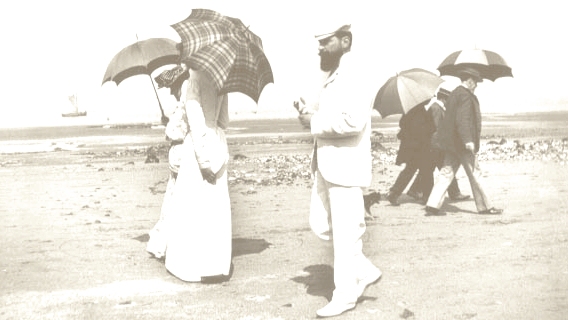"...as for me, I make no deductions, I infer nothing, I refrain from saying "therefore". Like Sancho Panza, "I come from my own vineyard; I know nothing." Perhaps I may venture to say that I have seen a lousy, lazy tramp drinking from a roadside stream that drips cold & pure from the rock in burning weather. Then the wastrel passes on his ill way, refreshed indeed, but as lousy & lazy as ever..."...The blindfolded approach of the girl in the epiphanic visit to the image in the wood parallels that of the hooded initiate in the Dionysian Mysteries, the mapless alchemical quest, & any number of notions of taboo. Faun-faced, priapic herms existed at every important crossroads in the Graeco-Roman world; Roman brides sometimes deflowered themselves on similar images, but it is unlikely that Machen meant to be as specific as all that. Rather, the concept of sympathia with the Deity is what is meant here...-Arthur Machen Things Near & Far
-
Machen contended that one should be good in order to be Christian, not the reverse.
Arthur Machen's The White People
commentary by rbadac
Violet Books
He did not attend a university, but set out in quest of spagyric wisdom, visiting laboratories in Paris, Basel, Salzburg, and Vienna...
...he earned his living by casting metallic mirrors.
He made medications, and even set aside an hour each day to administer free medicines.
Richard S. Westfall
The Galileo Project Development Team
updated Galileo Project
Rice University Honor Code
The most famous original source of Hermetic Alchemy is the Emerald Tablet of Hermes Trismegistus. While there are lots of writings attributed to “Hermes,” there is little agreement about the actual authorship of any of these writings. However, the author of the Emerald Tablet, whoever he may have been, is the Hermes who has given his name to “Hermetic Philosophy.” The basic Hermetic axiom is expressed there: As Above, so Below. This line has more than one meaning. In the first place, it suggests that the laws of the Cosmos may be found mirrored in Man: as the Macrocosm, so the Microcosm. But many other ideas are linked by the doctrine of correspondence. For example, there is a plane of pure energy, magnetism, or electrical field “above” that corresponds to the physical body of Man “below.” Even Plato voiced a similar idea: the Form of the Good (for example) exists “above” in correspondence to some physical reality of some good thing “below.” We might go on: Astrology posits the movements of the Heavenly bodies to exert corresponding influences on earthly events. Likewise, Sympathetic Magic is the art of establishing associative correspondence between objects not demonstrably connected (as in Tarot cards or Voodoo dolls).
By “Alchemy” is usually understood the Western Alchemical tradition which may have come from the Arabs of the Middle East and reached its highest development in the famous European Alchemists, but it is very interesting to notice that a parallel alchemical tradition has flourished in China with no perceivable connection to the Western Alchemical tradition, but which has symbols that are strikingly familiar. In The Secret of the Golden Flower, for example, there is described a process of evolution towards perfection featuring a “circulation of the light” that is practically a translation of the Emerald Tablet (from the Emerald Tablet: “It rises from Earth to Heaven, and then it descends again to the Earth, and receives Power from Above and from Below."
The Church of the Living Tree
The goal of the alchemical procedure is healing self-knowledge; (8) the extracted quintessence, equated with gold and the Stone as the final principle of truth, is a panacea. (9) Through the therapeutic power of alchemy wholeness is attained, the dissociation between the opposites healed, and the integration of the personality correspondingly achieved. (10) This redemptive aspect of alchemy is stressed by Paracelsus, who as a physician recognises the basic cause of disease to be a disturbance in the equilibrium of forces which exist as pairs of opposites. (11) One is reminded here of the medieval designation of "dis-ease" or imbalance as "passion" - an apt term in consideration of the Romantic, sometimes anguished self-awareness of the tension between the opposites. The origin of the word "spagyric," referring to the medicine derived from alchemy, appropriately derives from the Greek words for "divide" and "unite," reflecting the basic alchemical function of the imaginative self. (12)
'Ethereal Chemicals': Alchemy and the Romantic Imagination
Maureen B. Roberts
Romanticism on the Net Issue 5
Sylvia Townsend Warner
at Literary Encyclopedia
Sylvia Townsend Warner Society
Arthur Machen was Warner's uncle, whence the above, via a reference to Machen at Literary Encyc., which led to the Society which has a link to Amazon which has a listing for Machen's The Spagyric Quest of Beroaldus Comopolita.
All of which began with this link at Boynton, which sparked a memory of Eden Philpott's The Flint Heart. A google on that led to someone's mistranscription of Sylvia Townsend Warner's The Flint Anchor which evoked fond memories of her Kingdoms of Elfin tales in the New Yorker of my youth, and thus began what ends now here.



